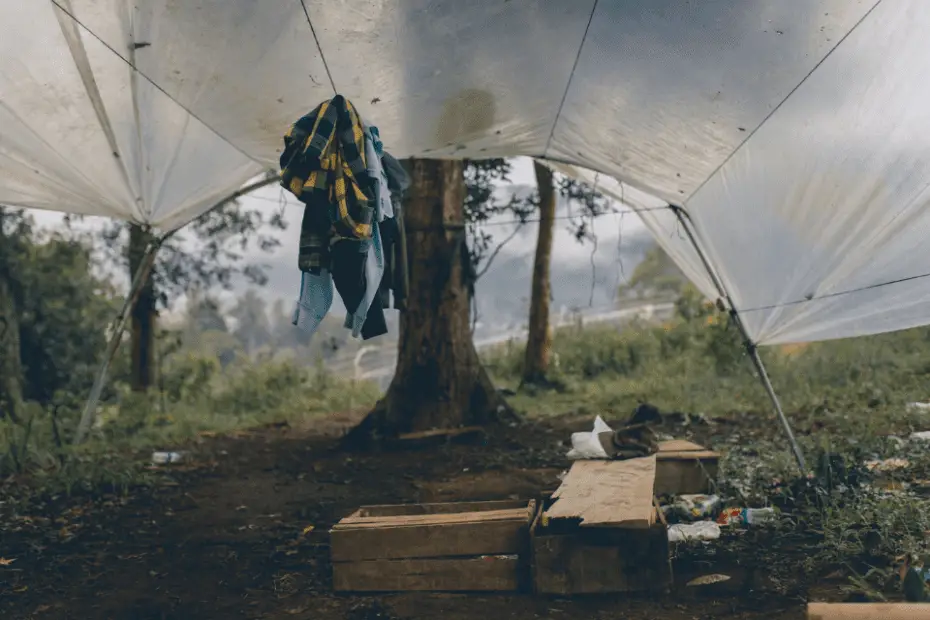There’s nothing worse than waking up in the morning and all your sleeping gear being wet after heavy rain in the night. If you are using a nylon tarp you might have thought this couldn’t happen, yet it has. In the following guide, I will provide you with an easy method for waterproofing a nylon tarp, to keep you dry on your next adventure.
In a hurry? Here’s the quick method. To waterproof a nylon tarp you will need to apply a new silicone-based solution to the material. This is a mixture 1 part clear silicone sealant to 3 parts odourless mineral spirit. Mix these and apply with a brush. Once dry you will have a waterproof tarp once more.
Whether you are using your tarp to cover over your tent, or simply using it as a shelter, read on to find out more about how it loses its waterproofing and the detailed method for fixing it.
What Is The Difference Between Ripstop Nylon And Silnylon?
Before we look at how you can waterproof your nylon tarp, it is important to know the difference between a Ripstop Nylon Tarp and a Silnylon Tarp:
Ripstop Nylon Tarp
Ripstop Nylon is a lightweight, woven fabric made from nylon, which uses reinforcement yarns woven at intervals to provide an extra strong, rip-resistant material.
Whilst the nylon is reinforced to protect it from long rips across the material, the reinforcements will not completely stop punctures and smaller tears in the material. However, the weaves in the fabric are usually so close together that any tear will barely be noticeable.
The benefits of a ripstop nylon tarp are that it is very strong given how light it is and small tears can’t spread through the material.
Silnylon Tarp
Silnylon is very similar to ripstop nylon in that it is woven, however, it has the added benefit of having an extra silicon-based layer of waterproofing.
It gets its name from the combination of Silicon and Nylon.
Whilst this material offers a significant amount of waterproofing, with water simply running off or beading on the top of the material, typically the material is less resistant to tearing and rips.
Waterproof Vs. Water Resistant Tarps

When choosing a suitable tarp is it also important to understand the difference between waterproof and water-resistant.
A waterproof tarp will repel water completely meaning that no matter how heavy the rain is that it is subjected to, you will remain dry when using it.
A water-resistant tarp is designed to repel a certain amount of water before it becomes wet and the water seeps through. The amount of water that it can resist is typically measured using the hydrostatic head method, which measures the number of millimetres of water that it would need to be subjected to before it leaks.
You’re probably wondering why you would bother buying a tarp that isn’t completely waterproof if it is available. The reason you might choose not to is that these materials are generally heavier than water-resistant materials. They are also less breathable, so if being used as a fully enclosed shelter you could get a bit hot and sticky inside it!
Why Is My Tarp No Longer Waterproof?
Over time the waterproofing of your tarp can wear away, making it far less effective at protecting you against the rain. Below are a few of the potential causes for this.
Exposure To The Sun
Plastic materials, such as silicon can be damaged when they are exposed to the sun for long periods of time. This is due to the energy from the ultraviolet radiation of the sun being absorbed by the material and leading to a weakening of the material.
If your silnylon tarp is subjected to strong sun for long periods, you might find that over time the material will lose its waterproof qualities.
Rubbing Against Other Materials
Another way that a tarp can lose its waterproofing is if it is subjected to frequent rubbing against other, more abrasive materials.
Rubbing against materials with an abrasive surface, such as velcro or sandpaper, will literally rub off the coating on the materials and therefore reduce its effectiveness against the rain.
Try to pack your tarp away separate from other materials and wipe off any excess dirt that there may be on it if it has been used as a groundsheet.
Storing Your Tarp Wet
There is nothing worse than needing to pack your tarp away when it is still wet and having that sinking feeling that you should get it out when you get home to dry out.
This is very important if you want to keep your tarp waterproof as leaving packed up dry and lead to mould and mildew forming on the material. This can degrade to materials waterproofing and again lead to your tarp being less effective against the rain.
How To Waterproof Nylon Tarp

Now we know what can stop our nylon tarp from being waterproof, let’s look at how to restore its super water repellent powers!
What you will need:
- One tube of Clear Silicone Sealent
- 950ml (one quart) of Odourless Mineral Spirit (Paint Thinner)
- One large empty metal paint tin
- Long wood/metal stirrer
- A large paint brush for applying the mixture to your tarp
- A set of scales for weighing the mixture
- Dust sheets
- Your tarp
Method:
- Prepare your tarp to be waterproofed
- Make sure that it is free from dust and dirt and is in a good, servicable condition
- Lay your tarp out on top of your dust sheets (or put it up if that is easier)
- Prepare your sealent mixture
- Your mixture will need to be 1 part silicone to 3 parts mineral spirit
- Put your empty metal tin on your scales and make sure the weight is set to zero
- Add 100 grams of silicone to the tin
- Add 300 grams of mineral spirit to the tin
- Stir like crazy using your stirrer until the silicon is all mixed into the mineral spirits. This can take up to 5 minutes.
- It is ready when the mixture is uniform and runny
- Using your paint brush, paint the mixture onto your tarp in long, overlapping brush strokes. It is better to cover the same areas twice by overlapping than it is to miss parts by attempting to avoid overlapping.
- Cover your mixture and brush and leave the tarp to dry. You should leave the first coat overnight to dry.
- Repeat the process for the other side of the tarp until both sides are covered.
Method Tips:
- You should prepare your sealant mixture in smaller amounts to make sure it doesn’t dry out if left standing in the paint tin.
- Clean your paint brush with the mineral spirit once you are complete
- Try and do this in a well ventilated area. This will help you avoid getting headaches when working with spirits.
- Feel free to test the mixture on a small section of the tarp before covering the whole thing. Better that just one section is not protected rather than the whole tarp!
Can The Seams Leak On My Tarp?
Whilst the process above will work to protect the main surface of your tarp, if your tarp has a seam in it, this will need to be treated separately with a seam sealer.
The process for doing this is pretty straightforward. Simply lay the seam of the tarp flat, apply the seam sealer and leave it to dry.
Always check the packaging of the seam sealer and follow the instructions on there to make sure you get the best waterproof seal on the seams of your tarp.
Summary
Thanks for reading this guide. I hope you now know more about waterproofing a nylon tarp and making sure you remain dry on your next camping adventure.
If you liked this guide, please share it on Pinterest. Also, please check out our other guides to all things outdoors.
Happy Camping!


